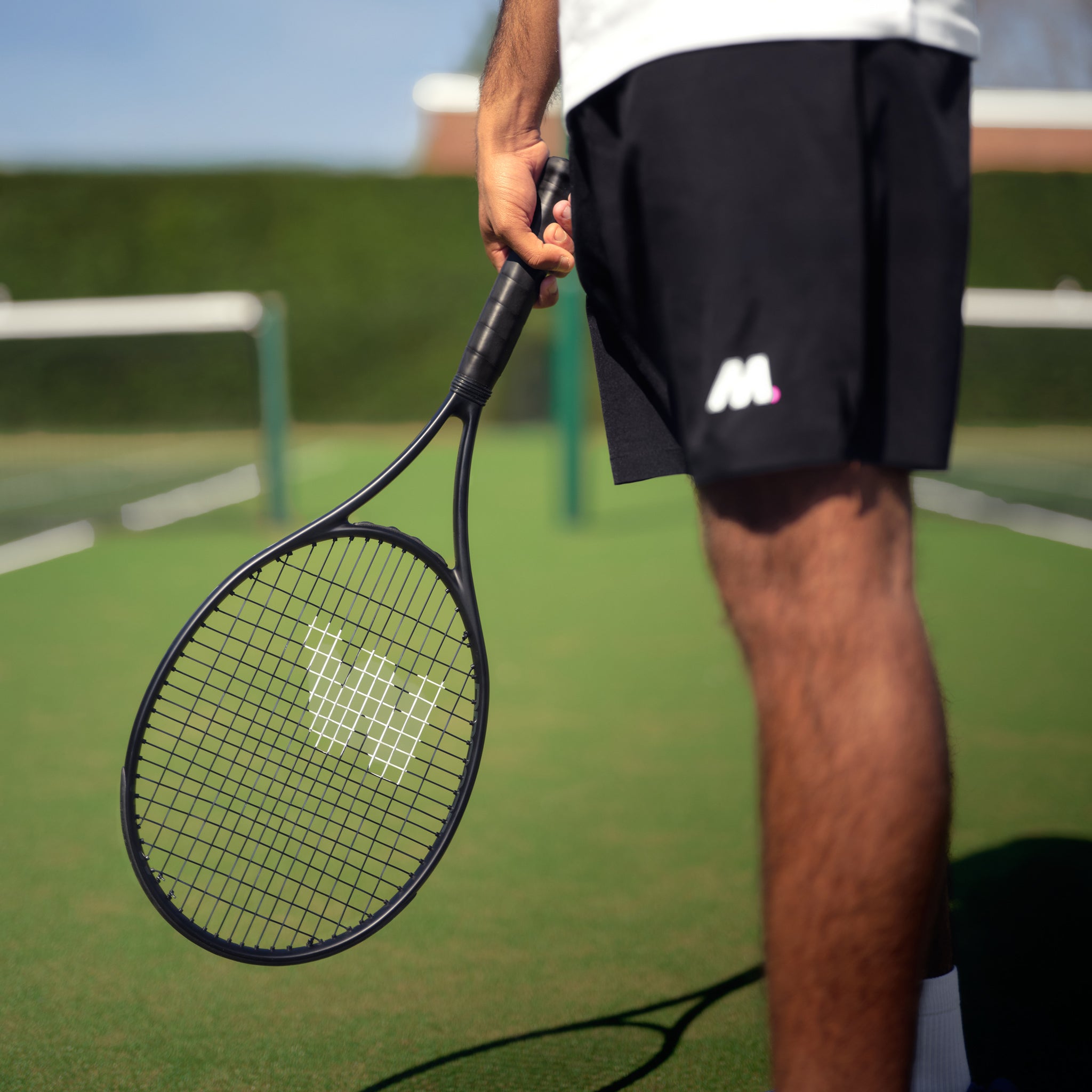
Ever cracked open a new can of tennis balls? That satisfying psssst sound is the final note in a symphony of manufacturing, a meticulous process that transforms humble lumps of rubber and wool into the high-performance spheres we rely on for every match. To see how tennis balls are made read on or to see the results of this expert and dedicated production process, you can explore the Mantis range of tennis balls on our website.
At Mantis, we're obsessed with getting this process just right. It's a delicate dance between material science and mechanical precision, all aimed at one thing: creating a ball with the perfect bounce, flight, and durability.
How Tennis Balls Are Made: A Journey From Rubber to a Perfect Bounce
It all starts with the heart of the ball: the rubber core. To see the results of this dedication, you can explore the Mantis range of tennis balls on our website. This isn't just any rubber; it's a specialised compound that forms the foundation for that lively bounce we all expect. We start by mixing, heating, and pressing this compound into two identical half-shells. Think of them as two little rubber bowls.
Next, these hemispheres are fused together with a powerful adhesive. But here's the clever part: just before they're sealed, a shot of pressurised air is trapped inside. This internal pressure is the secret sauce. Without it, the ball would be dead on the bounce, completely useless for a proper game.
From Core to Court-Ready
With the pressurised core complete, it's time to give the ball its iconic fuzzy jacket. That bright yellow felt isn't just for looks—it's absolutely crucial for the ball's aerodynamics.
This stage involves a few key steps:
- A specific blend: The felt is a carefully chosen mix of natural wool and nylon. This combination gives the ball the right balance of a soft touch and rugged durability.
- Precision application: The felt is first cut into that distinctive "dog-bone" or dumbbell shape. Two of these pieces are then wrapped and bonded seamlessly onto the rubber core.
- Controlling the flight: This felt covering, known as the nap, is what helps control the ball’s speed, spin, and trajectory through the air. It’s what allows players to hit a slice that bites or a topspin shot that kicks.
From the initial rubber mix to the final bounce check, the entire manufacturing process is governed by strict quality control. Every single Mantis ball undergoes a series of tough inspections to guarantee it meets our exacting standards for consistency and performance.
Before they're ready for you, the finished balls are steamed to fluff up the felt fibres, stamped with our logo, and then sealed into those familiar pressurised cans. This last step is vital, as it keeps the balls factory-fresh, ensuring they have the exact same pressure when you open them as they did when they left our facility. Ready for the court.
Below is a quick overview of the entire process, broken down into its main stages.
Key Stages in Tennis Ball Manufacturing
| Stage | Process Summary | Key Materials |
|---|---|---|
| 1. Core Moulding | A special rubber compound is mixed, heated, and moulded into two half-shells. | Specialised rubber compound |
| 2. Core Assembly | The half-shells are bonded together, trapping pressurised air inside to create the core. | Rubber hemispheres, adhesive |
| 3. Felt Application | Two dumbbell-shaped pieces of felt are wrapped and glued onto the surface of the core. | Wool/nylon felt blend, adhesive |
| 4. Finishing & QC | The felt is steamed to fluff the nap, the logo is applied, and the ball undergoes quality checks. | N/A |
| 5. Packaging | Finished balls are sealed in pressurised cans to maintain internal pressure until use. | Pressurised metal or plastic cans |
This table highlights the journey from raw materials to the finished product you hold in your hand, a journey guided by precision at every step.
Crafting the Rubber Core
Every tennis ball starts its life with a rubber core. To see the results of this dedication, you can explore the Mantis range of tennis balls on our website. You could say it’s the heart of the ball, as its quality is what ultimately determines how well the ball bounces and how long it lasts. Getting this foundation right is a game of precision, starting with a very specific recipe.
We begin with a high-quality blend of natural rubber, chosen for its fantastic elasticity. To this, we add a cocktail of specific chemical agents. Some speed up the curing process, while others add sheer strength and durability. This concoction is churned in huge industrial mixers until it becomes a completely uniform, dough-like compound. Consistency is everything here.
This rubber compound is then fed into an extrusion machine—imagine a massive, industrial-scale pasta maker. It heats and forces the rubber through a mould to create long, thick ropes. These are instantly chopped into small, precisely weighed pellets, which we call slugs.
From Slugs to Hemispheres
Each one of those slugs contains the exact amount of rubber needed to make one-half of a tennis ball core. There's no room for error; even a tiny difference in weight could ruin the ball's balance and flight.
Next, these slugs head to the compression moulding machines. Inside, hundreds of hemispherical moulds are waiting. The slugs are dropped in, and the machine clamps shut, applying a huge amount of heat and pressure. This forces the soft rubber slugs into the shape of perfect half-shells.
But it’s not just about getting the shape right. This step triggers a vital chemical reaction known as vulcanization.
Vulcanization is a process that fundamentally changes the rubber's molecular structure. It creates strong cross-links between the rubber's polymer chains, turning it from a soft, sticky material into the tough, bouncy, and incredibly durable substance we need for a high-performance tennis ball.
Without this crucial step, the core would never survive the first rally.
Preparing for the Perfect Seal
Once the vulcanization is done, the moulds pop open, revealing neat rows of rubber hemispheres. After they’ve cooled down, they’re ready for the next step, but they can't be joined just yet.
First, a special vulcanizing cement is carefully applied to the rim of each half-shell. This isn't just any glue; it's an adhesive designed to create a permanent, airtight bond when the two halves are fused together with more heat and pressure.
This part of the process is meticulously controlled.
- Precision is paramount: If there's too little cement, the seal will be weak, and the ball will go flat in no time.
- Uniformity is key: The coating must be perfectly even around the entire rim to ensure a seamless, structurally sound sphere.
- Curing time matters: The adhesive needs a moment to set before the two halves are brought together for the final press.
This careful prep work guarantees that when the two halves finally meet, the seam is just as strong as the rest of the core. It’s this flawless bond that allows the core to hold the pressurised air that gives a tennis ball its iconic bounce.
Getting the Bounce Right: Pressurisation and Sealing
This is where the magic really happens. We take two separate rubber half-shells and turn them into the single, unified core that gives a tennis ball its signature bounce. It's a process we've perfected at Mantis, involving a specialised press that applies intense heat and precise pressure to fuse the halves together. The results of this engineering speak for themselves in the Mantis range of tennis balls.
This clever bit of machinery does two jobs at once. As it heats the halves, it activates a vulcanising cement on the rims, creating a bond that will never break. In that same moment, just before the halves are sealed shut, the machine injects a carefully measured amount of pressurised gas inside.
It's All About Internal Pressure
That gas trapped inside the core is what gives the ball its lively rebound. The internal pressure is typically set to about 12 PSI (pounds per square inch) higher than the atmospheric pressure outside. It’s a bit like pumping up a bike tyre – the amount of air dictates how firm it is and how it performs. For a tennis ball, this pressure is the secret ingredient for that crisp, responsive feel off the racket strings.
The type of gas we use is just as important. While you could technically use compressed air, almost all high-performance balls, including ours, are filled with nitrogen.
Why nitrogen? It comes down to simple physics. Nitrogen molecules are bigger than oxygen molecules, which makes it much harder for them to leak out through the tiny, microscopic pores in the rubber. This means the ball holds its pressure for longer, giving you a consistent bounce for the entire life of the ball.
It’s this attention to detail that ensures a can of Mantis balls performs exactly as you expect, from the very first serve to match point.
Creating the Perfect Sphere
Once fused and pressurised, the core isn't quite ready. The heat and pressure create a permanent, airtight seam, but the newly formed sphere needs to cool down in a controlled environment to stabilise.
After cooling, each core goes through a buffing process. This is essentially a light sanding that smooths away any excess rubber or tiny imperfections left over from the moulding stage.
Buffing is critical for a few reasons:
- A Flawless Surface: It creates a perfectly uniform canvas, which is essential for applying the felt cover evenly.
- Consistent Balance: By removing any tiny lumps or bumps, it ensures the ball is perfectly balanced for a true flight through the air.
- Better Adhesion: The process creates a slightly roughened texture, giving the adhesive for the felt something to grip onto, ensuring a secure bond.
Now we have a perfectly sealed, consistently pressurised, and flawlessly smooth rubber core. It has all the bounce, balance, and durability needed for high-level tennis. It's finally ready for its iconic yellow jacket.
Applying the Signature Felt Covering
A bare rubber core, no matter how perfectly pressurised, would be completely unplayable on a tennis court. It's that iconic fuzzy covering—the nap—that really makes a tennis ball what it is. This felt is what gives the ball its unique aerodynamic qualities, allowing for spin, control, and a predictable flight path.
Here at Mantis, we know this stage is crucial. It’s where a simple rubber sphere is transformed into a piece of high-performance sports equipment. To see how this fits into the bigger picture, you can explore our full range of Mantis tennis balls and see the finished product.
The felt itself is a bit of a marvel. It's a carefully engineered blend of natural wool and synthetic nylon, woven together into massive, bright yellow sheets. This combination gives you the best of both worlds: the wool provides that soft, fluffy feel for grip and spin, while the nylon adds the rugged durability needed to survive punishing serves and long, gruelling rallies.
From Sheet to Sphere
Before the felt can meet the core, it goes on its own little journey. First, a powerful adhesive is coated evenly across one side of the giant felt sheets. Then, the material is fed into a cutting machine that stamps out perfectly identical pieces in that distinctive dumbbell or "dog-bone" shape.
You need exactly two of these pieces to cover a single tennis ball. The shape is ingenious—it’s designed so that when the two halves are wrapped around the sphere, their edges meet flawlessly to form that seamless figure-eight pattern we all know.
The Bonding Process
This is where modern automation really shines, ensuring every single ball is consistent. The buffed rubber cores and the cut felt pieces are loaded into a sophisticated machine where robotic arms perform a delicate, high-speed ballet. One arm grabs a core while others pick up two felt pieces.
With incredible precision, the arms wrap the adhesive-backed felt around the core. The whole operation is designed to prevent any wrinkles, bubbles, or misalignments. It’s a swift, flawless process that showcases how modern manufacturing can achieve uniformity on a massive scale.
But the job isn't done yet. That adhesive needs to be set permanently. The felt-covered balls head back into a press, much like the one that sealed the core, where they're treated with both heat and pressure. This cures the adhesive, creating an unbreakable bond between the felt and the rubber.
A fascinating thing happens during this pressing stage: the famous white seam is born. The intense pressure squeezes a tiny amount of the adhesive through the join where the two felt pieces meet. This seeping glue then cures, forming that familiar white line.
This whole intricate process is a world away from how things used to be done. Well into the mid-1900s, tennis balls were made by covering rubber cores with hand-stitched wool flannel. Even the fluorescent yellow colour we see today is a relatively new invention, only introduced in 1972 to make the ball easier for television viewers to follow.
Woven vs Needle-Punched Felt
Not all tennis ball felt is the same, and the type used has a huge impact on how the ball plays and how long it lasts. There are two main types you’ll come across: woven felt and needle-punched felt.
-
Woven Felt: Think of this as the premium option, the kind you'll find on championship and professional-grade balls. The wool and nylon fibres are literally woven together on a loom, creating a tough, compact, and incredibly consistent cloth. Woven felt wears down evenly and its fibres fluff up just enough to maintain good aerodynamics, ensuring a predictable flight and bounce right through a long match.
-
Needle-Punched Felt: This is more common for recreational or coaching balls. Instead of weaving, the fibres are tangled and locked together by being punched with thousands of tiny needles. It's a faster and cheaper way to make felt, but the trade-off is durability. The fibres on these balls tend to fluff up more quickly and can become matted, which changes how the ball flies and bounces over time.
At Mantis, we only use woven felt for every ball we produce. Whether it's destined for a high-stakes tournament or a tough training session, we make sure it has the perfect covering for its job.
Ensuring Performance with Rigorous Quality Control
The journey of a tennis ball isn't over once the felt is sealed to the core. In many ways, the most critical steps are just beginning. At Mantis, we know that consistency is king on the court, which is why a series of final touches and incredibly strict quality checks are so important. Every single ball has to meet the exacting standards set by the International Tennis Federation (ITF). To see the result of this dedication, you can explore our full range of Mantis tennis balls.
With the felt securely bonded, the balls get a quick steam bath. It might sound a bit like a spa treatment, but this step is purely functional—it fluffs up the wool and nylon fibres of the felt nap. This process creates that signature fuzzy texture that’s absolutely vital for the ball's aerodynamics and grip. Once they’re properly fluffed, the balls are stamped with the Mantis logo.
Now, with the finishing touches done, the balls head to the final, most demanding stage of all: inspection. This is a blend of high-tech automated machinery and the trained eyes of our expert team, all working to ensure total perfection.
Passing the Ultimate Test
Every ball that comes off our line has to run a gauntlet of tests before it even gets close to a can. These checks aren't just for show; they’re designed to make sure that every ball in a tube, and every tube in a case, performs exactly as it should. This is how we guarantee the fair and reliable experience players expect. If a ball fails even one of these tests, it’s immediately pulled from the production line. No exceptions.
The primary tests include:
- Weight: Each ball must weigh in within a very tight range. Too light, and it’ll fly all over the place. Too heavy, and it will feel like a rock and could even lead to injury.
- Size: We measure the diameter with extreme precision. An oversized or undersized ball completely changes how it bounces and feels coming off the strings.
- Deformation: This test measures how much the ball squashes under a specific load and, crucially, how well it springs back to shape. It’s the ultimate indicator of the core’s quality and the ball's long-term durability.
The Science of the Bounce
Of all the quality control measures, the bounce test is probably the most famous. According to ITF rules, a tennis ball dropped from a standard height of 100 inches (254 cm) onto a hard, flat surface (like concrete) must rebound to a height somewhere between 53 and 58 inches.
This isn't just a guideline; it's a non-negotiable rule. It ensures that a ball behaves predictably on every court surface, from the hard courts of the US Open to the clay of Roland-Garros and the grass of Wimbledon. This standardisation is the bedrock of the sport.
This deep-rooted commitment to quality is what sets a premium ball apart from a cheap one.
To give you a clearer picture of just how precise this process is, the table below breaks down the key specifications every single ITF-approved tennis ball must meet.
ITF Tennis Ball Approval Standards
| Parameter | ITF Approved Specification | Purpose of the Standard |
|---|---|---|
| Mass (Weight) | 56.0 g – 59.4 g | Ensures consistent flight, bounce, and feel, preventing erratic behaviour and reducing player strain. |
| Size (Diameter) | 6.54 cm – 6.86 cm | Guarantees uniformity for predictable interaction with the racket and court surface. |
| Rebound Height | 135 cm – 147 cm (from 254 cm) | Standardises the bounce characteristics for a fair and consistent game across all levels of play. |
| Deformation | 0.56 cm – 0.74 cm (Forward) | Measures the ball's compression to control its pace and ensure it has the right amount of "give". |
These meticulous checks really highlight the science and engineering that go into making a tennis ball, ensuring every single one is ready for the rigours of competitive play.
The Global Supply Chain of a Tennis Ball
A tennis ball’s journey doesn't just start and end on a single factory floor. It’s a truly global affair. The process of getting from raw materials to the finished products you see in our range of Mantis tennis balls criss-crosses continents, relying on a complex web of suppliers and manufacturers. This international dance is what makes it possible to get the high-quality, specialised components needed for a top-performing ball.
Think of a modern tennis ball as a small, fuzzy testament to global trade. Its core ingredients are often sourced from thousands of miles apart, with each region contributing a unique material or skill. This worldwide sourcing allows us to access the very best components for every part of the ball.
Sourcing Materials Across Continents
Putting together a tennis ball is a bit like solving a complex logistical puzzle, with pieces coming from all corners of the globe. A typical breakdown of where key components might originate looks something like this:
- Natural Rubber: This is the heart of the ball's core. It's usually harvested from rubber tree plantations in Southeast Asian countries like Thailand and Malaysia.
- Specialised Clays: These are mixed into the rubber compound as fillers, adding durability and helping to fine-tune the bounce. High-quality clays for this are often sourced from mines across Europe and North America.
- Wool for Felt: That iconic fuzzy exterior needs premium wool, especially for the durable woven felt on championship balls. A lot of this comes from New Zealand, which is famous for its high-grade sheep farming.
When you think about it, the humble tennis ball has often travelled much farther than many of the players who use it before it even gets a chance to bounce on a court.
The global nature of tennis ball production highlights a fascinating intersection of sport and logistics. It’s a system designed to bring together the best materials from around the world to create a single, consistent product, connecting distant factory floors to the world's most prestigious courts.
Frequently Asked Questions About Tennis Balls
It's one thing to know how a tennis ball is made, but quite another to understand the little details that affect your game. At Mantis, we find that the more you know about your gear, the better you play. Let's tackle some of the most common questions we hear from players just like you. To see the results of this dedication, you can explore the Mantis range of tennis balls on our website.
Lots of players ask about the difference between pressurised and pressureless balls. Think of a pressurised ball as a tightly sealed container; its bounce comes from the pressurised air trapped inside its rubber core. This is what gives professional tournament balls that crisp, lively pop off the strings. The downside? Once you pop the can, they start losing that pressure and, eventually, their bounce.
Pressureless balls are a different beast altogether. Their bounce comes from the inherent structure of the rubber core itself, not from internal air pressure. This makes them incredibly durable and consistent over time, but they often feel a bit heavier and less "lively" during play.
Why Do Tennis Balls Have Numbers?
Ever wondered about those little numbers printed on the side of a tennis ball? It's a surprisingly simple and practical solution to a common problem at busy tennis clubs.
When you've got games happening on adjacent courts, it's almost guaranteed that balls will go astray. Those numbers—usually 1, 2, 3, or 4—are just there to help you tell your balls apart from the ones that have rolled over from the court next door. If both courts are using Mantis balls, a quick glance at the number saves any confusion and keeps the game flowing.
How Long Do Tennis Balls Last?
This is the million-dollar question, and the answer really depends on the type of ball and how you're using it. For the pros, a can of fresh pressurised balls might only be used for 7-9 games before they're swapped out. The moment that can is opened, the internal pressure starts to seep out, and the ball's performance begins to decline.
For the rest of us, a set of pressurised balls can last for a few good practice sessions before they start to feel "dead." Learning how to keep tennis balls fresh can certainly help, but once the seal is broken, the clock is ticking.
Pressureless balls, on the other hand, are built for the long haul. They're the marathon runners of the tennis ball world. Their bounce stays consistent for a much longer time, which is why they're perfect for filling up coaching baskets and ball machines. They don't go flat, but the felt will eventually wear down, and the rubber will lose some of its natural elasticity over time.
At Mantis, we pour our passion for the sport into creating high-performance tennis equipment that helps you play your absolute best. From our ITF-approved tennis balls to our precision-engineered rackets, every product is designed with the player at its very core. Explore our full collection and feel the difference on the court. https://mantissport.com








